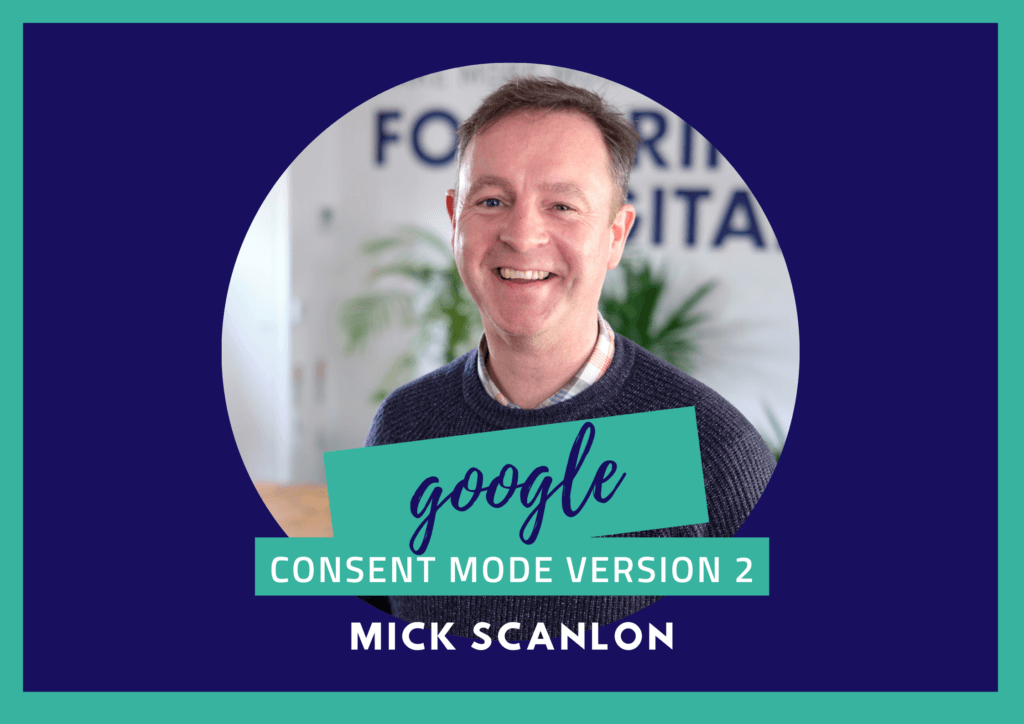
Laws like the ePrivacy Directive (2002) and the General Data Protection Regulation (GDPR, 2018) controls the way that organisations and businesses can store and use people’s data.
It means that businesses must have proper reasons for collecting and storing data about people, and website owners have to collect informed consent from their users in the EU and the EEA before they are allowed to use online tracking cookies and collect personal data.
Google’s response to this was to create ‘consent mode’ in 2020 which was a way to enhance the privacy and control over their own data for Google’s users, whilst also providing a way for websites to gather important marketing data.
This year, Google has launched ‘Consent Mode Version 2’ and has provided a deadline of this month (March 2024) to get this in place.

What’s the difference between consent mode V1 and V2?
Compared to the original consent mode, version two offers stronger alignment with privacy laws and gives users more control over their data through the new parameters of ad_user_data and ad_personalization, meaning that personal user data can only be accessed with explicit consent from users.
How do I know if I already have consent mode V2?
There are a few ways to check if your website is already using consent mode V2.
The first way is to go to your Google Tag Manager and click on the consent tab. Check that those two new parameters (ad_user_data and ad_personalization) are there and on page defaults are set.
You can also check in your GA4 account by going to Admin>Data streams>Web stream details>Consent settings.
Get in touch with us if you need help clarifying whether you’re using version 1 or 2 currently.
The impact on remarketing
If you have a Google ads account and you don’t do any remarketing, then your ads probably won’t be impacted. You’ll be able to carry on delivering campaigns that are almost like cold calling online ads, rather than ads specifically targeted to certain people or groups.
So, going after completely new business and new visitors to your website will be able to continue BUT if you’re remarketing and using remarketing lists, potentially at some point you won’t be allowed to use those any more.
From past experience of other cookie updates, like original consent mode, you’ll get an alert in your ads account that tells you what you aren’t allowed to do any more.
We’ve seen these kinds of alerts before for some of our clients based on industry or specific data sensitivities, but I think we’ll start to see these alerts showing up for more ‘bog standard’ or non-sensitive industries, too.
This is not the end of the world, and we don’t need to panic. You can still deliver campaigns, but your remarketing campaigns may have to stop at some point – we’re keeping a close eye on this.
How is consent mode going to impact newer ad campaign formats?
A lot of the newer campaign formats like Performance Max and Demand Gen campaigns use your audience lists as a lookalike signal of who your ideal customers are so that they can find more of those types of people to advertise to.
Well, potentially if you’re not allowed to use your audience lists anymore, you will lose that ability to plug data into Performance Max, Demand Gen and even Display ads, so the logical conclusion from that loss of data is that your campaigns will not perform as well as they could.
For instance when you’re building Performance Max campaigns, there are three different types of data that Google wants you to input. The first is demographics – age, gender, topics of interest.
The second is keywords, and the third element is your first party data. If you’re only allowed two of those three signals, it’s not going to perform as well as it could. One of the things we’ve seen over the past year is that using your own first party data is the key to taking ads performance to the next level.
We need to think about data modelling
This hasn’t been talked about as much as potentially losing remarketing and impacting other ad formats, but it’s very important. All of the data that you provide the system – your lists but also your activity – all of that is being used and digested to make decisions for you through machine learning, but what Google is saying now is that you won’t have the ability to use that kind of information, regardless of whether you’re using audiences.
Again, if we take Performance Max as an example, a lot of what it does is data modelling what you’re potentially going to get from delivery to certain audiences.
Well, if you’re delivering a Performance Max campaign right now, and you have access to data modelling, Google is looking at let’s say 100 people that could be shown your ad, and Google is saying based on data modelling that 50% of those people won’t be interested, 50% will be so they’ll put you into those 50 auctions or in front of those 50 people.
In the future, if we don’t have access to that data modelling, and Google’s got 100 potential visits, it might just tell you to get in front of everyone, and there your efficiency will start to go down, your performance might suffer, and so might your results and ROI.
This point has been overlooked somewhat because of the immediacy of the other two points. Long-term, the longer you can’t use the system in the way it’s designed to be used, the more your results are going to suffer.
So, what’s the solution?
Google has provided some guidelines for consent mode which are fairly impenetrable, so we’ve digested it for you and have three main takeaways.
The first of these takeaways is you need to understand what your current consent setup looks like on your website.
There is a list of approved consent management systems, like Cookiebot and some others, and if you’ve already bought into one of those systems and using that on your website, you can log into your system and upgrade to V2 and your consent mode should all be updated for you to V2.
It should update your banners, your cookie text etc. However, this may vary depending on which system you’re using so it’s best to go in and have a look as soon as possible.
The second takeaway is that if you aren’t using a consent platform, you’ll need an in-house solution. It’s a case of getting your developers to update your consent policy on your website, and it has to be in line with what Google is saying.
Unfortunately, Google is currently being vague on what you need that to say, but we have got some guidance on this.
The third thing is to monitor, measure and make sure that this is working over time. Google has said that there will be a tool available to do this where you can plug in your website and they’ll tell you if you’re V2 compliant, but it’s not available yet.
Do websites need Google Tag Manager to be able to implement Consent Mode?
No, if you’re using a consent platform then you should be able to log into your account and update from there. If you’re using Google Tag Manager, and you’ve put your current consent and tagging in place through GTM, then you will use GTM to update the tags that are related to consent right now.
The third route to updating this would be almost hard coding the website. If you’re on a bespoke platform then that might be one of the things you’ll have to look at, and that might be quite messy and complex.
Most people will either have a cookie consent platform or Tag Manager, a minority might work on a bespoke platform and need extra support.
Will consent mode impact your website’s SEO as well as your PPC?
Short answer, yes. When you read the headlines you might get distracted by the immediacy of losing Google ads results, so everyone’s worried about PPC, but the long term impacts on your SEO and overall marketing strategy and ability to plan using data will be felt, too.
If you don’t implement this you’re going to start to get less from your GA4 data, which will have implications on what you can do organically, and what data and reports you can collect and analyse.
The knock on from that is if you are not complaint and you website isn’t trustworthy and ticking all the boxes, you could be subject to a lawsuit – we talked about this a lot when V1 came into effect and some websites ignored the need to have a cookie consent policy in place and they were subject to a lawsuit.
There were a few big cases almost as an example to the industry so we’re probably facing a similar situation and at the moment we don’t know how detrimental that may be. But this is all about complying with current law and data protection, so it needs to be taken very seriously by all websites.
How can we help?
Our SEO and PPC teams will happily support you with consent mode; however, depending on how your system is set up and what platforms you are using will depend on how much time and how complex our support needs to be – this really is a case by case, bespoke service so the best thing to do is to get in touch with our team and ask about consent mode support. We will then be able to scope out the level of support that you need, and go from there.







